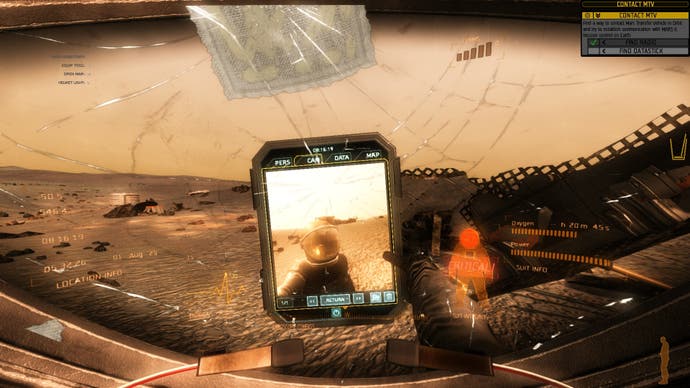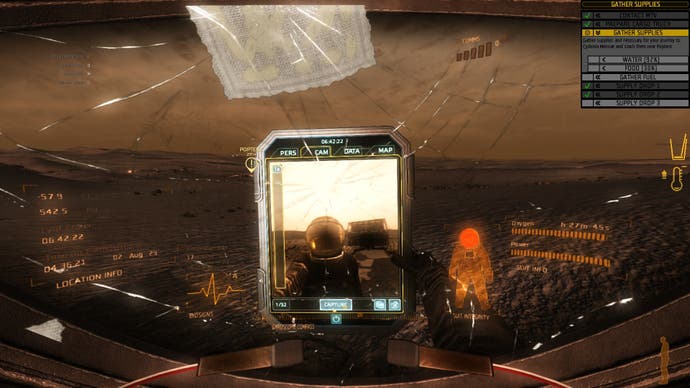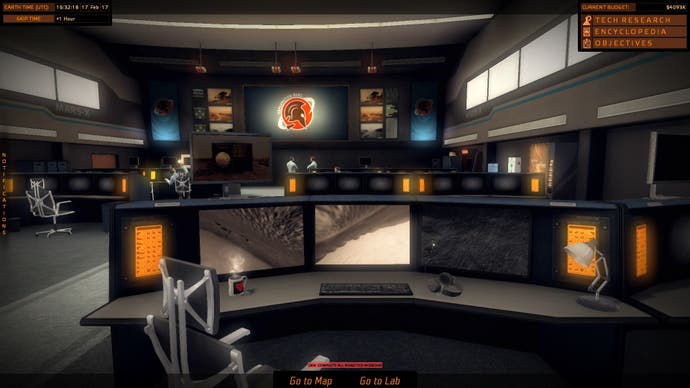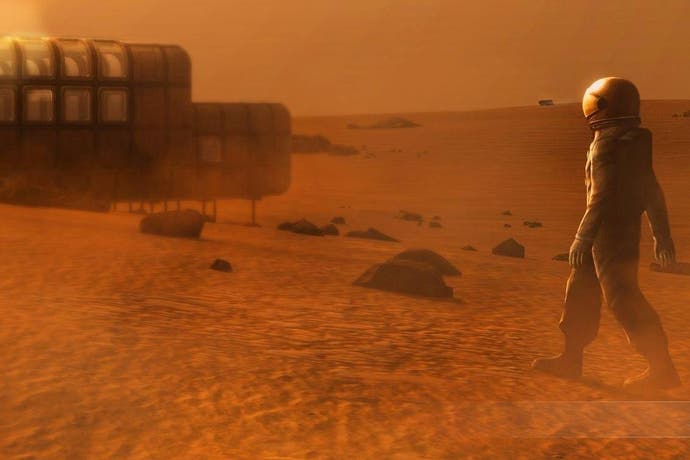Take on Mars review
Crossing the Weir.
My favourite thing about Take On Mars is that you can use your PDA to take selfies. This may sound like a weird and pointless feature, and in a lot of ways it is. But when you're alone on an entire planet that will passively murder you for making the slightest mistake, the ability to take a photo of yourself is surprisingly comforting.
Here is a selfie of me at my spaceship's crash site, that left all of my crewmates dead. You can't see it because of the reflective visor, but I am secretly crying. Lol!

Here is a selfie of me with my COOL CARGO TRUCK.

Here is a selfie of me without my helmet on.

By the way, you shouldn't remove your helmet while standing outside on Mars. It totally sucks!
I love Take on Mars' selfie feature, just as I love the fact that all vehicles have an interactive computer terminal on the dashboard, and that the Cargo truck has buttons that deploy a tailgate ramp and staircases on the flanks. It's little features like these which lend Bohemia Interactive's games such a unique flavour, and I've respected them for it since the days of Operation Flashpoint. Unfortunately, Take On Mars is also typically Bohemian in less enjoyable ways, and I ultimately found myself wondering if the resources that went into these details might have been better spent elsewhere.
Taken to the extreme, one could argue that Take on Mars would be better off focussing on being one great game instead of two admirable yet undeniably clunky games. Take on Mars' campaign is split into two very different chapters. The first places you in charge of a realistic Mars exploration program, tasked with deploying increasingly complex robots to the red planet to complete a long list of scientific goals. The second chapter, by comparison, is more speculative and dramatic, casting you as a member of the first manned mission to Mars, which crash lands and leaves you alone on the planet's inhospitable surface.
Both sides of the game are substantial, inventive, and struggle to fully realise their vision. The space programme, for example, introduces you to the game by plonking you in front of a terminal at mission control with minimal explanation of what you're supposed to do or how you're supposed to do it. As it transpires, your first goal is to map the surface of Mars by dropping a bunch of probes at key locations, which is actually very simple to do. It's also phenomenally boring. Watching ten metal wedges parachute to the ground through a fuzzy camera lens doesn't exactly make for a compelling introduction.

What it does do, however, is put a bit of money in your bank, which you can use to research some new technologies and build slightly more advanced probes that take samples of the Martian atmosphere. Gradually, you work your way up to Martian landers, small rovers, and eventually Curiosity-sized robotic laboratories capable of performing a multitude of experiments.
At this point Take on Mars becomes rather more interesting, as it leans more toward exploring the eerie Martian surface, which is another triumph of environment design from Bohemia. The developers have captured the desolate beauty of this world, its rust-coloured dunes stretching to the horizon, its pitch-black nights revealing a galaxy of stars.
While there's plenty to be done in Take on Mars' space programme, I nevertheless find the experience to be a little barebones. Take on Mars skips the issue of getting your probes and rovers to Mars in the first place, which I've been led to believe is a significant factor in space exploration. Moreover, completing any objective in the game involves an awful lot of repetition, and it doesn't really communicate much sense of ingenuity or achievement to the player. You can build custom landers and rovers if you wish, but there isn't a great deal of room for experimentation. Unlike, say, Kerbal Space Program, failure doesn't lead to an amusing consequence and a lesson learned, it leads to running out of budget and being forced to restart.
The space programme improves as it goes on, but it's a long road to get there. Perhaps this is why Bohemia decided to add the second, manned chapter, which offers slightly more immediate entertainment. Here you play as Astronaut Mark Watney - sorry, I mean Willis - the lone survivor of Earth's disastrous first manned mission to Mars. From waking up with a cracked face-mask and only seconds of oxygen remaining, you must overcome both short and long-term challenges that threaten your survival, and learn how to thrive in this intensely hostile environment.
The manned campaign takes place over a sequence of increasingly open-ended missions, culminating in you constructing your own Martian base. Interspersed within these survival missions are flashbacks to Willis' time on the International Space Station and Earth's Moon base, which add a little variety to Mars' pretty but largely barren environments.
What makes the manned chapters interesting are the processes you need to go through to stay alive. Creating water, for example, requires a host of technical equipment, including a soil extractor, a source of power, and a materials refinery. Each of these must be anchored into the ground and connected via cables. The refinery can break up different types of Martian soil and rock into various component materials, including vital ones like air, water, and methane (which is used as fuel for vehicles). These in turn are stores in canisters that can be installed into your vehicles, your habitat, and so on.
There's satisfaction to be had in many of Take on Mars' routines. Parking up your Cargo truck at a supply drop, deploying the ramps, suiting up, cycling the airlock, and stepping out into the sickly white glow of the Martian sun all lends a powerful sense of tactility to your Martian adventure. This level of detail is applied to most of your interactions in the game. Sadly, enjoying these moments require you to put up with some bizarre design decisions and a general lack of polish.
There's no escaping it, Take on Mars is incredibly clunky. The controls are loose and imprecise. Shifting objects around is extremely cumbersome, and the game's physics engine is best described as "springy". Moving a crate filled with resource canisters is like navigating a box of rabbits across a bouncy castle. Collision detection is equally sketchy, producing frequent glitches and bugs. While cycling the airlock on the moon-base, for example, a prompt appeared on the wall that said "Board Vehicle". Since I was looking for my lunar buggy anyway, I pressed the button, and was instantly transported to the toilet on the far side of the wall. Less amusing glitches include regularly falling over inside one of your vehicles and smashing up your EVA suit, because the game struggles to handle confined spaces.

What's more, some of the missions are atrociously designed. The fourth mission requires you to gather up large amounts of food, water and oxygen to complete it. But you also need to eat the food and drink the water to stay alive during the mission. Eat and drink too much, however, and it becomes impossible to complete. You don't "fail" the mission explicitly, it just carried on indefinitely. Even if you manage to complete it, the whole process is far longer and more tedious than it needs to be.
Take on Mars is also openly inspired by Andy Weir's bestseller the Martian, or perhaps more accurately, Ridley Scott's film adaptation. Everything from the cracked visor in the opening, to growing potatoes as crops, and even the aesthetic design of your Martian vehicles, all directly reference the work of Weir and Scott. But Take on Mars lacks the same wit and charm that contributed to the success of the film and book. Indeed, Take on Mars has some of the worst writing I've encountered in a long time. For example, when building the Cargo truck, Willis tells the truck to watch out, because he's a "DIY enthusiast", a phrase that has never been spoken by any human being in the history of mankind. Meanwhile, during a flashback rescue mission on the moon, Willis tells his unconscious commander "Don't do this to me again!" as if his Commander was a beloved spouse who just awoke from a coma.
Such flaws have recurred in Bohemia's games for a long time, and in previous years I've been more inclined to forgive them because of the ambition demonstrated by games like Operation Flashpoint and ArmA III. But I can't do that with Take on Mars, because there are so many survival games and simulators available nowadays which simply do this stuff better, that offer detailed systems and compelling mechanics while also getting the basics right. In addition, Take on Mars has been in Early Access for three years, more than enough time to iron the wrinkles out of their tech, to realise that their script was cringeworthy garbage, to test the fucking campaign to ensure collecting 1200 units of oxygen to install in your mobile laboratory is actually fun. None of which is to say it's a game without merit. One Martian evening, I was outside my pop-tent assembling the equipment for the soil extractor. I noticed the light had begun to dim, and I looked up at the sun, faint and white and distant, and the colour slowly draining from the rocky sands all around. All of a sudden, I felt a tremendous sense of solitude, a palpable sense of my place within this vast, uncaring, incredible universe.
It's a sensation I don't feel very often in games, and in that moment all the frustration, the annoying bugs, the torturous dialogue, felt worthwhile. Take on Mars isn't short of problems, but when everything works together, it really does feel like you're there.










